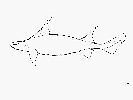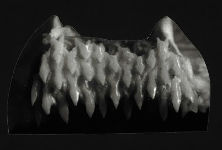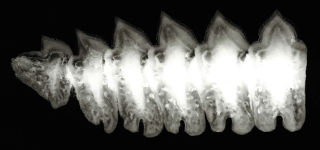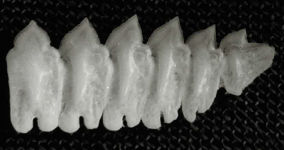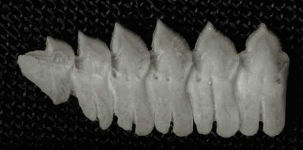Oxynotus paradoxus
Frade, 1929
Sailfin roughshark
Classification: Elasmobranchii Squaliformes Oxynotidae
Reference of the original description
Une nouvelle espèce ou une aberration individuelle de l'Oxynotus centrina (L.). Bulletin de la Société Portuguese de Sciences naturales, (1–15), 10(22), 263–267
Une nouvelle espèce ou une aberration individuelle de l'Oxynotus centrina (L.). Bulletin de la Société Portuguese de Sciences naturales, (1–15), 10(22), 263–267
Description :
Citation: Oxynotus paradoxus Frade, 1929: In: Database of modern sharks, rays and chimaeras, www.shark-references.com, World Wide Web electronic publication, Version 01/2026
Please send your images of "Oxynotus paradoxus" to info@shark-references.com
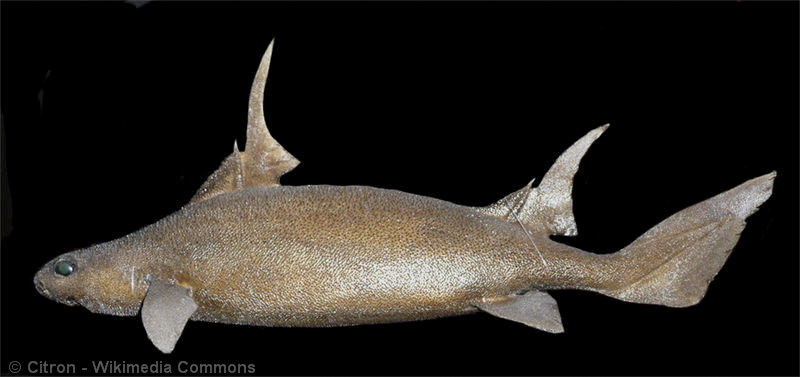
Oxynotus paradoxus Frade, 1929, © Citron, wiki

Oxynotus paradoxus Frade, 1929, © Citron, wiki
Common names
 Graue Meersau,
Graue Meersau,  Cerdo marino velero,
Cerdo marino velero,  Humantin,
Humantin,  Kite-fin shark,
Kite-fin shark,  Sailfin rough shark,
Sailfin rough shark,  Sailfin roughshark,
Sailfin roughshark,  Peixe-porco-de-vela
Peixe-porco-de-vela
 Graue Meersau,
Graue Meersau,  Cerdo marino velero,
Cerdo marino velero,  Humantin,
Humantin,  Kite-fin shark,
Kite-fin shark,  Sailfin rough shark,
Sailfin rough shark,  Sailfin roughshark,
Sailfin roughshark,  Peixe-porco-de-vela
Peixe-porco-de-vela
Short Description
Spiracle small and circular. Supraorbital ridges not greatly expanded and not forming a knob in front of spiracles. Predorsal spine length from snout to first dorsal–fin spine 2.7 in precaudal length. Pectoral fins strongly falcate. Apices of dorsal fins narrowly triangular, posterior margins strongly concave. First dorsal–fin spine inclined rearwards. First dorsal–fin anterior margin from spine to apex 2.5 in first dorsal–fin spine height, second dorsal–fin anterior margin from spine to apex 2.1 in second dorsal–fin spine height. Second dorsal–fin base 1.6 to 2.0 in interdorsal space, second dorsal–fin origin opposite pelvic–fin origins. Vertebral counts: total vertebral count 95, monospondylous vertebral counts 46 to 50, precaudal vertebral counts 62 to 64, caudal vertebral count 31. Intestinal valve turn counts unavailable. Adults to 118 cm. Colour: blackish or darkbrown, without prominent markings. [17836]
Spiracle small and circular. Supraorbital ridges not greatly expanded and not forming a knob in front of spiracles. Predorsal spine length from snout to first dorsal–fin spine 2.7 in precaudal length. Pectoral fins strongly falcate. Apices of dorsal fins narrowly triangular, posterior margins strongly concave. First dorsal–fin spine inclined rearwards. First dorsal–fin anterior margin from spine to apex 2.5 in first dorsal–fin spine height, second dorsal–fin anterior margin from spine to apex 2.1 in second dorsal–fin spine height. Second dorsal–fin base 1.6 to 2.0 in interdorsal space, second dorsal–fin origin opposite pelvic–fin origins. Vertebral counts: total vertebral count 95, monospondylous vertebral counts 46 to 50, precaudal vertebral counts 62 to 64, caudal vertebral count 31. Intestinal valve turn counts unavailable. Adults to 118 cm. Colour: blackish or darkbrown, without prominent markings. [17836]
Distribution
Endemic to the Eastern Atlantic, found along the Atlantic Slopefrom Scotland (including the northernNorth Sea), to Ireland, southern England, France, Spain, Portugal, and the Azores. Also, occurs off Madeira Islands, the Canary Islands, Morocco, Mauritania, Western Sahara, Senegal, and possibly southwards to the Gulf of Guinea region. Apparently absent from the Mediterranean. [17836]
Records:
10.03.1949 by Richard Crofts in 603 m depth at a point 250 miles W by S. of St. Ann's Head/England (female, 89,5 cm TL) [2937];
07.05.1988 in demersal gill nets by the MFV 'Silver Fern' (Skipper: Mr Michael Murphy, Dingle) at a depth of 120m about 9.4km off Ballydavid (Q380100), Co Kerry. (female, 63,5 cm TL, 2,35 kg weight, National Museum of Ireland coll.nr. NMI 59.1989). [9338];
23.06.1992 by the MFV 'Jacob' (Skipper: Mr Donie Flaherty, Dingle) at a depth of 240m off Slyne Head (L510410), Co Galway [9338];
December 1994 by a trawler fishing off the west coast of Ireland captured (female, 76,0 cm TL, 5300 kg weight) [9341];
mid-November 1994 by the MFV 'Cornelius Ferdinand1 (Skipper: Mr Michael O'Connor, Dingle) while trawling at an approximate depth of 240m NNW of Slyne Head, Co Galway (c53°50'N, 11°W; ICES 7B) (female, 74,5 cm TL, 2,55 kg weight) [9342];
10.09.1993, at a depth of approximately 600 m, near Banco Voador, southeast of Flores Island (37°35’N, 30°48’W), using bottom gill nets (female, 62,8 cm TL); in 1995, with the only indication of having been captured in the banks near Pico island (male, 54,9 cm TL) [108]; Source: www.gbif.org
Endemic to the Eastern Atlantic, found along the Atlantic Slopefrom Scotland (including the northernNorth Sea), to Ireland, southern England, France, Spain, Portugal, and the Azores. Also, occurs off Madeira Islands, the Canary Islands, Morocco, Mauritania, Western Sahara, Senegal, and possibly southwards to the Gulf of Guinea region. Apparently absent from the Mediterranean. [17836]
Records:
10.03.1949 by Richard Crofts in 603 m depth at a point 250 miles W by S. of St. Ann's Head/England (female, 89,5 cm TL) [2937];
07.05.1988 in demersal gill nets by the MFV 'Silver Fern' (Skipper: Mr Michael Murphy, Dingle) at a depth of 120m about 9.4km off Ballydavid (Q380100), Co Kerry. (female, 63,5 cm TL, 2,35 kg weight, National Museum of Ireland coll.nr. NMI 59.1989). [9338];
23.06.1992 by the MFV 'Jacob' (Skipper: Mr Donie Flaherty, Dingle) at a depth of 240m off Slyne Head (L510410), Co Galway [9338];
December 1994 by a trawler fishing off the west coast of Ireland captured (female, 76,0 cm TL, 5300 kg weight) [9341];
mid-November 1994 by the MFV 'Cornelius Ferdinand1 (Skipper: Mr Michael O'Connor, Dingle) while trawling at an approximate depth of 240m NNW of Slyne Head, Co Galway (c53°50'N, 11°W; ICES 7B) (female, 74,5 cm TL, 2,55 kg weight) [9342];
10.09.1993, at a depth of approximately 600 m, near Banco Voador, southeast of Flores Island (37°35’N, 30°48’W), using bottom gill nets (female, 62,8 cm TL); in 1995, with the only indication of having been captured in the banks near Pico island (male, 54,9 cm TL) [108]; Source: www.gbif.org
Human uses
fisheries: minor commercial; price category: not marketed/unknown; price reliability:
fisheries: minor commercial; price category: not marketed/unknown; price reliability:
Size / Weight / Age
Maximum about 118 cm; an adult male was 75 cm long. Size at birth about 25 cm [17836]
Maximum about 118 cm; an adult male was 75 cm long. Size at birth about 25 cm [17836]
Dentition
Teeth on upperand lower jaws dissimilar; uppers smaller than lowers, lanceolate, broadlyerect, triangular in medial rows, narrow and blade–like in posterior rows,cusps smooth–edged, with no lateral cusplets or blades, in quincunx formationin a narrow triangular pad and not imbricated; lower teeth imbricated, with amedially erect, distally oblique broad, sharp–edged, serrated cusp, and nolateral cusplets; tooth counts upper jaw 13, lower jaw 9 [17836], tooth formula 13/5-1-5(n=1) [3640]
Links: SEM-images of teeth
Teeth on upperand lower jaws dissimilar; uppers smaller than lowers, lanceolate, broadlyerect, triangular in medial rows, narrow and blade–like in posterior rows,cusps smooth–edged, with no lateral cusplets or blades, in quincunx formationin a narrow triangular pad and not imbricated; lower teeth imbricated, with amedially erect, distally oblique broad, sharp–edged, serrated cusp, and nolateral cusplets; tooth counts upper jaw 13, lower jaw 9 [17836], tooth formula 13/5-1-5(n=1) [3640]
Links: SEM-images of teeth
Remarks
shark-references Species-ID=4481;
shark-references Species-ID=4481;








